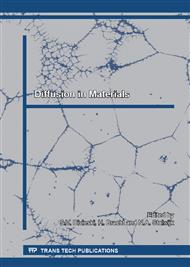[1]
M. J. Powell, The physics of amorphous-silicon thin-film transistors, IEEE Trans. Electron Devices. 36 (1989) 2753-2763.
DOI: 10.1109/16.40933
Google Scholar
[2]
A. Shah, Photovoltaic Technology: The Case for Thin-Film Solar Cells, Science. 285 (1999) 692–698.
Google Scholar
[3]
M. T. McDowell, S. W. Lee, W. D. Nix, Y. Cui, Understanding the lithiation of silicon and other alloying anodes for lithium-ion batteries, Adv. Mater. 25 (2013) 4966-4985.
DOI: 10.1002/adma.201301795
Google Scholar
[4]
C. Spinella, S. Lombardo, F. Priolo, Crystal grain nucleation in amorphous silicon, J. Appl. Phys. 84 (1998) 5383-5414.
DOI: 10.1063/1.368873
Google Scholar
[5]
H. Schmidt, M. Gupta, M. Bruns, Nitrogen Diffusion in Amorphous Silicon Nitride Isotope Multilayers Probed by Neutron Reflectometry, Phys. Rev. Lett. 96 (2006) 055901.
DOI: 10.1103/physrevlett.96.055901
Google Scholar
[6]
H. Schmidt, W. Gruber, T. Gutberlet, M. Ay, J. Stahn, U. Geckle, M. Bruns, Structural relaxation and self-diffusion in covalent amorphous solids: Silicon nitride as a model system, J. Appl. Phys. 102 (2007) 043516.
DOI: 10.1063/1.2770821
Google Scholar
[7]
S. Chakravarty, H. Schmidt, U. Tietze, D. Lott, N. P. Lalla, A. Gupta, Self-diffusion and defect annihilation in nanocrystalline Fe films probed by neutron reflectometry, Phys. Rev. B. 80 (2009) 014111.
DOI: 10.1103/physrevb.80.014111
Google Scholar
[8]
H. Schmidt, M. Gupta, T. Gutberlet, J. Stahn, M. Bruns, How to measure atomic diffusion processes in the sub-nanometer range, Acta Mater. 56 (2008) 464-470.
DOI: 10.1016/j.actamat.2007.10.005
Google Scholar
[9]
R. Kube, H. Bracht, E. Hüger, H. Schmidt, Contributions of vacancies and self-interstitials to self-diffusion in silicon under thermal equilibrium and nonequilibrium conditions, Phys. Rev. B. 88 (2013) 85206.
DOI: 10.1103/physrevb.88.085206
Google Scholar
[10]
S. Mirabella, D. De Salvador, E. Bruno, E. Napolitani, E. F. Pecora, S. Boninelli, F. Priolo, Mechanism of Boron Diffusion in Amorphous Silicon, Phys. Rev. Lett. 100 (2008) 155901.
DOI: 10.1103/physrevlett.100.155901
Google Scholar
[11]
G. T. Barkema, N. Mousseau, Identification of Relaxation and Diffusion Mechanisms in Amorphous Silicon, Phys. Rev. Lett. 81 (1998) 1865.
DOI: 10.1103/physrevlett.81.1865
Google Scholar


